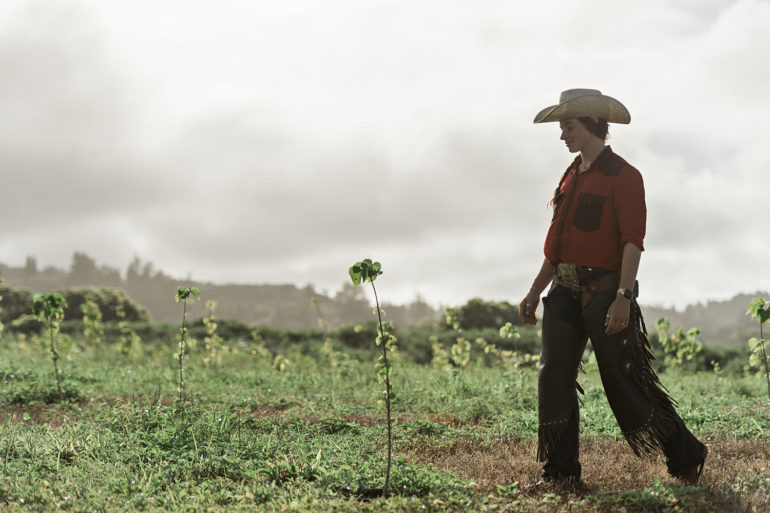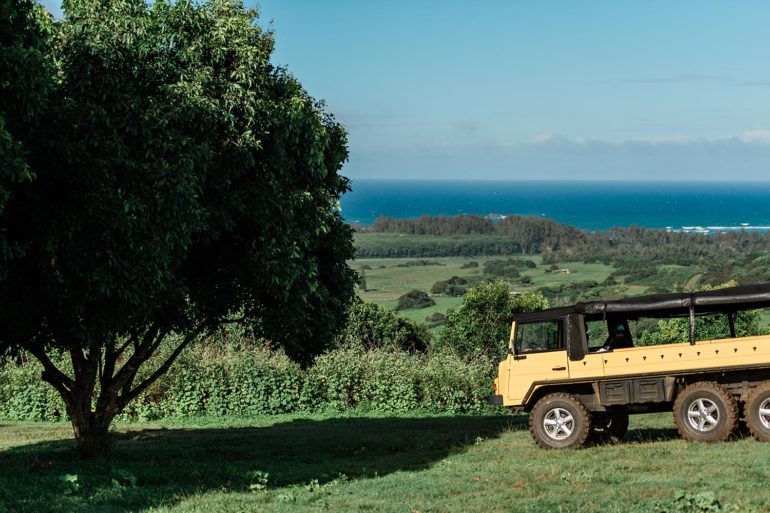Lilia Tollefsen, chief operating officer of Gunstock Ranch, hops into the front seat of the ranch’s bright yellow Pinzgauer beside ranch wrangler Kali Marino. Gunstock Ranch owner Greg Smith and I climb in behind them and we motor up a dirt path, stopping to let a group of horseback riders pass before zigzagging through the glistening trees along a damp, grassy trail.
We arrive at the first lookout in the tour and take in the view under the shade of a massive banyan tree. Gesturing across an expanse of tree canopy stretching toward the base of the Ko‘olau mountain range, Smith explains that Gunstock is in the process of turning 500 acres of non-native growth and former pastureland into a thriving native forest, an effort launched in 2018 in partnership with the nonprofit Hawaiian Legacy Reforestation Initiative.
To date, the Hawaiian Legacy Reforestation Initiative has planted more than 400,000 endemic koa, ‘ōhi‘a, māmane, naio, ko‘oko‘olau, kūkaenēnē and ‘iliahi (sandalwood) trees at two sites on Hawai‘i Island. Here at Gunstock Ranch on O‘ahu, the reforestation effort is centered around milo, a native Hawaiian canoe plant that is also thought to be indigenous to the area. “They’re creating an ecosystem,” Tollefsen shouts over the hum of the engine, “not just planting trees.”
At the second stop in the tour, I’m greeted by a sweeping panorama of Windward O‘ahu and regaled with tales about Waiapuka, a nearby water hole revered in Hawaiian folklore as the piko (navel) of the Ko‘olau Range. There’s a palpable spirituality about the place, even more so when we reach our destination: the ‘Alohilani forest. We’re met with rows upon rows of vibrant green saplings, their broad, heart-shaped leaves heavy with raindrops and bobbing in the breeze.
It’s here that guests of ‘Alohilani Resort can take part in the hotel’s commitment to plant 100,000 indigenous trees on O‘ahu and the Big Island. Guests contribute to the cause with the $5 “tree fee” ‘Alohilani includes in each room charge, or they can book tree-planting tours through the hotel concierge to plant their own “legacy trees” in commemoration of a person or special event. “We like to tell people to come out here themselves because something happens when you get your hands dirty, when you’re the one planting the tree,” Tollefsen says. “Something changes, you watch it in people’s eyes.”
Sunlight bursts through the clouds, giving the landscape a warm patina of light. Marino coaxes a spindly milo sapling out of its bucket for me to set in the ground and pat into place. As she gives the sapling its first drink of water from the mouth of a wooden gourd, I’m instructed to focus on my intention for the tree and the purpose of its dedication. “We all have a spirit, or mana,” Tollefsen says. “We tell people to share their mana with their tree, and their thoughts and memories get wrapped up into it as it grows.”
An engagement, the birth of a child, the death of a loved one—they’re all cause to put a tree in the ground. All the trees are assigned radio-frequency identification tags, so tree planters can go online and check in on their tree from anywhere in the world.
Gusts of wind wash through the tall grasses with a roar like white water in a wave, and the surrounding forest heaves as if swept by an underwater current. But even with the resounding buzz of crickets and the wind loud in my ears, the landscape alive all around us, there is a stillness and quiet—and beneath it all, countless stories raising a forest from the land, one tree at a time.








